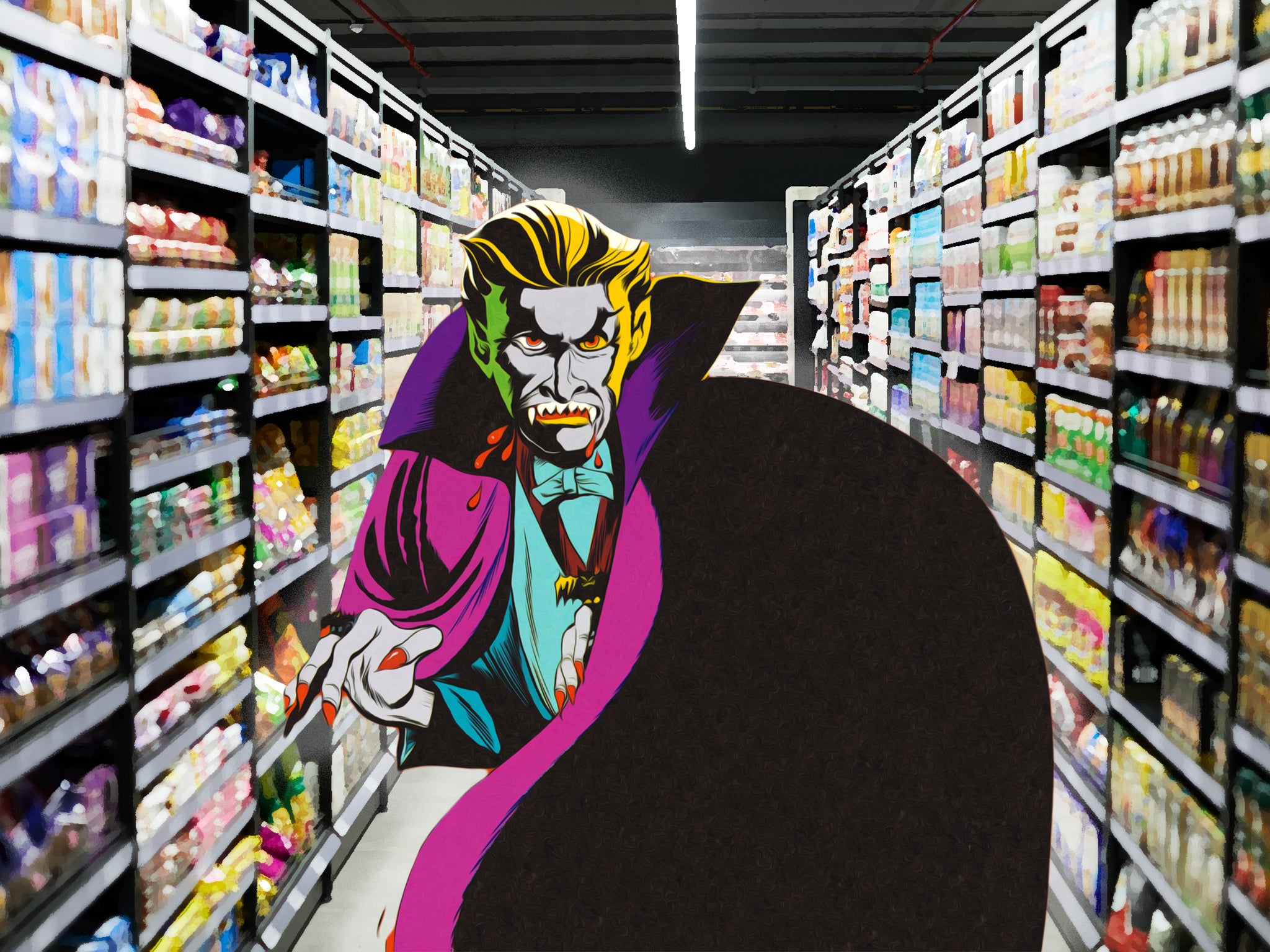‘We’ve got zombie finger beef kebabs’: How British supermarkets became Halloween-mad
Venture into your local supermarket this Halloween season and you’ll find everything from Count Dracula chocolate cake to evil garlic bread. How did the UK become a hub of spooky variants on everyday products, asks Adam White


Your support helps us to tell the story
From reproductive rights to climate change to Big Tech, The Independent is on the ground when the story is developing. Whether it's investigating the financials of Elon Musk's pro-Trump PAC or producing our latest documentary, 'The A Word', which shines a light on the American women fighting for reproductive rights, we know how important it is to parse out the facts from the messaging.
At such a critical moment in US history, we need reporters on the ground. Your donation allows us to keep sending journalists to speak to both sides of the story.
The Independent is trusted by Americans across the entire political spectrum. And unlike many other quality news outlets, we choose not to lock Americans out of our reporting and analysis with paywalls. We believe quality journalism should be available to everyone, paid for by those who can afford it.
Your support makes all the difference.Somewhere between the bread and the cheeses in your local supermarket is a section that reappears each September in ever-greater size. Call it Invasion of the Shelf Snatchers. It’s decorated with black cats and pumpkins, an occasional witch, and filled with ghoulish spins on everyday products – from Marks & Spencer’s “petrified garlic bread” to Morrisons’ “toxic frog chocolate”. I’m assured these are edible. This year Aldi is stocking not one but two variations on creepy crumpets, while Asda (sorry… “Asdaaargh!”) has launched a line of “Spookilicious Fairy Cakes”. Sainsbury’s has gone one further, introducing a “Monstrous Count Dogula Chocolate Cake”.
As a child of the Nineties, I’ll confess that this has thrown me. Back then, the most you expected from Halloween in Britain was a themed episode of Sabrina the Teenage Witch and the vague suggestion of going trick-or-treating. Then your mum would “get a headache” and a sad bag of Swizzels Rainbow Drops in front of the TV would be your only treat. Halloween sweets, meanwhile, meant plain old multi-packs of Haribo – not Aldi’s Red Leicester with a Chili Cheese Witches Cauldron. So, what happened?
“Today Halloween is probably second only to Christmas in terms of importance to retailers,” says Lou Ellerton, senior director at data agency Kantar. “In around 15 years or so, it’s gone from being a small scale thing only really relevant to young families, to a celebration that reaches across all ages and demographics.” She thinks the internet is partly to blame. “YouTube has made American culture so much a part of everyday life here. When I was a child, Halloween was a very minor thing and only in America was it celebrated in all its glory. That’s changed radically.”
The speed of that change has been profound. Only five years ago The Guardian was declaring that Halloween hadn’t “really taken off in Britain” – a claim that looks almost quaint in 2022. According to the market data company Statista, sales of Halloween products hit more than £600m in 2021. To put that into perspective, Halloween-related sales in 2001 amounted to just £12m. Enormous amounts of grocery sales research also goes into the amount of Halloween food that gets manufactured, too, meaning the season doesn’t create as much food waste as you might imagine.
Come the autumn, practically every supermarket now experiments with their own Halloween branding but Marks & Spencer seems to be the market king – a version of their trademark Colin the Caterpillar cake wrapped in bandages is truly something we should be worshipping as if it were a holy deity.
Katy Patino is the product development manager for ambient foods at M&S – so basically the Prue Leith of terrifying ingestibles. While I imagined that the process behind the Halloweenification of your shopping trolley involved all kinds of Lovecraftian tinkering, it’s actually remarkably simple: product developers take top-selling products that buyers already love, and just make them Halloweeny.
“This year we’ve launched a large pizza made up of little round pizzas that look like eyeballs,” she chuckles. “It’s called the ‘Eye Want Pizza’. We’ve got zombie fingers which are, you know, beef kebabs. We’ve got ‘Hell-oumi fingers’, which taste great. We’ve got some really delicious white chocolates that are hand decorated and, again, look like eyeballs. They’re quite realistic, as inside they’ve got a raspberry compote. When you bite into it, you get a gooey, red compote coming out. We’ve called them ‘oozing eyeballs’.”
Gore aside, there’s a delicate balance to strike. “It’s about having a lot of fun without being too gruesome and offensive,” she says. “I think the most difficult thing probably is making it family friendly.” Seasonal plans are put together more than a year in advance, she adds, meaning she and her team have already devised the grim delicacies we’ll be ingesting this time next year.
Ellerton suggests we’ve only skimmed the surface of Halloween retail in Britain. “Supermarkets were among the first to recognise its appeal,” she says. “They’ve made Halloween accessible and mass market in a way that it never really was when it was restricted to costume shops or specialist retailers. And the more they introduce things like Halloween-themed food, the more it’ll become a part of the national psyche.”
Spare a thought, though, for poor old Guy Fawkes. Thanks to Halloween gobbling up all the shelf space, Bonfire Night on 5 November seems to be shrinking ever more in importance. Ellerton gets it, though. “I guess it’s quite difficult to commemorate in food somebody being hanged, drawn and quartered…”
Somewhere, though, a lightbulb has gone off in a product developer’s mind.



Join our commenting forum
Join thought-provoking conversations, follow other Independent readers and see their replies
Comments